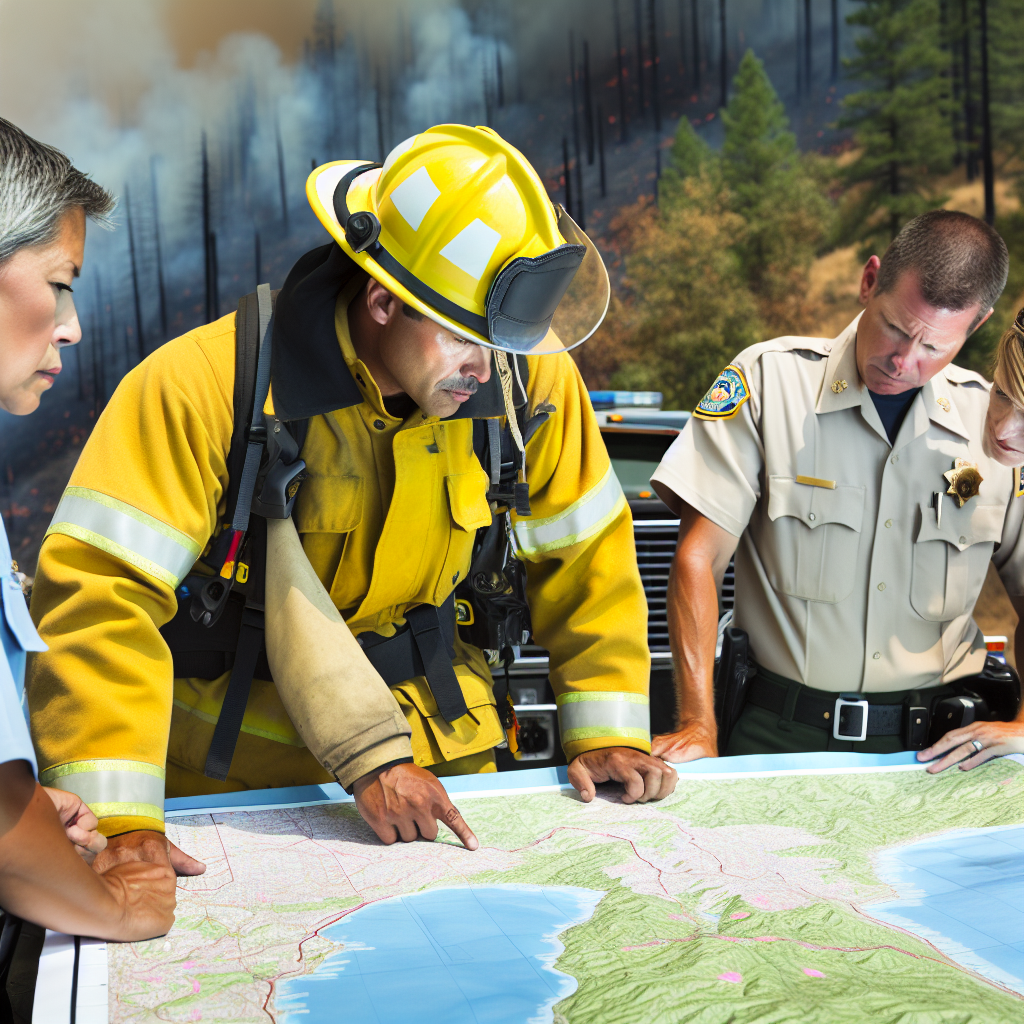Introduction:
A wildland firefighter is a trained professional who specializes in combating fires in rural areas.
Importance of coordination with local authorities:
Coordination with local authorities is crucial for effective wildfire response and containment.
Brief overview of the topic:
Wildland firefighters work hand in hand with local authorities to ensure the safety of communities and landscapes.
Overview of the Role of Wildland Firefighters
Wildland firefighters are highly trained individuals.
They work in a variety of terrains and weather conditions.
Wildland firefighters suppress fires to protect communities.
They also safeguard natural resources and wildlife from destruction.
Responsibilities of Wildland Firefighters
Wildland firefighters are responsible for extinguishing fires.
They construct fire lines and conduct controlled burns.
Providing support to other emergency responders is essential.
They often work long hours in challenging conditions.
Their goal is to contain wildfires and prevent them from spreading.
Challenges They Face in the Field
Wildland firefighters face numerous challenges in the field.
Unpredictable weather conditions pose significant risks.
They navigate rugged terrain with limited resources.
The threat of rapidly spreading fires is ever-present.
Safety must be prioritized in hazardous environments.
Need for Efficient Coordination with Local Authorities
Wildland firefighters must work closely with local authorities.
Fire departments, law enforcement, and emergency management officials are key partners.
Effective response to wildfires relies on communication.
Transform Your Career Today
Unlock a personalized career strategy that drives real results. Get tailored advice and a roadmap designed just for you.
Start NowCollaboration and coordination are essential for a cohesive response.
Importance of coordination with local authorities:
Coordination with local authorities is crucial for wildland firefighters to effectively respond to emergencies and protect lives and property.
Effective communication is essential during firefighting operations to ensure that all stakeholders are informed and can make timely decisions.
Local authorities play a vital role in managing resources and allocating them based on the needs of the firefighting operation.
By collaborating with local agencies, wildland firefighters can access additional resources and support that are crucial for a successful firefighting effort.
Seamless deployment and coordination of firefighting efforts require coordination with local authorities to ensure a swift response to emergencies.
By working together, firefighters can streamline their operations and respond effectively to changing conditions on the ground.
Overall, coordination with local authorities is a key factor in the success of wildland firefighting operations.
By fostering strong relationships and communication channels, firefighters can enhance their effectiveness and ensure the safety of both responders and the communities they serve.
- Ensuring effective communication during firefighting operations
- Collaborating on resource management and allocation
- Facilitating seamless deployment and coordination of firefighting efforts
Learn More: Work Environment and Conditions for Secret Service Agents
Collaboration with law enforcement agencies:
Wildland firefighters often collaborate closely with local law enforcement agencies to ensure public safety during wildland fires.
Ensuring public safety during wildland fires:
Law enforcement agencies play a vital role in assisting wildland firefighters in ensuring the safety of the public during fire emergencies.
They help in communicating evacuation orders and providing support in managing crowds and traffic.
Coordinating road closures and evacuations:
One of the key tasks of wildland firefighters working with local authorities is coordinating road closures and evacuations in affected areas.
Law enforcement agencies help in managing traffic flow and guiding people to safety.
Working together to enforce fire safety regulations:
Collaboration between wildland firefighters and law enforcement agencies also extends to enforcing fire safety regulations.
They work together to educate the public about fire prevention measures and ensure compliance with local fire codes.
The coordination between wildland firefighters and local authorities, particularly law enforcement agencies, is essential in managing wildland fires effectively and safeguarding public safety.
By working together, they can mitigate the impact of wildfires and protect communities from harm.
Showcase Your Business Today
Reach thousands of readers actively exploring professional services. Publish your business profile and grow your audience now.
Publish NowExplore Further: Work Environment and Conditions for CBP Officers
Coordination with emergency services:
- Collaborating on medical response for injured firefighters or civilians
- Ensuring timely evacuation and rescue operations
- Coordinating resources for emergency response efforts
Wildland firefighters play a crucial role in managing and extinguishing wildfires. They can’t do it alone.
Coordination with local authorities and emergency services is essential to ensure a swift and effective response to fire incidents.
One key aspect of this coordination is collaborating on medical response for injured firefighters or civilians. Wildland firefighters often work in dangerous and remote locations.
This makes it crucial to have a plan in place for medical emergencies. By working closely with local emergency services, firefighters can ensure that injured personnel receive prompt and appropriate medical care.
Another important aspect is ensuring timely evacuation and rescue operations. When wildfires threaten communities, firefighters must work with local authorities.
They need to coordinate evacuation efforts and ensure the safety of residents. This may involve developing evacuation plans and communicating with the public.
Coordinating resources for emergency response efforts is also crucial in wildland firefighting. Local authorities and emergency services may have access to specialized equipment or personnel.
By collaborating and sharing resources, firefighters can enhance their response capabilities and better protect lives and property.
Learn More: Security Consultant Job Market Trends

When it comes to wildland firefighting, effective coordination with local authorities is crucial for successful fire management and prevention efforts.
Wildland firefighters must maintain open lines of communication with government officials.
They should seek necessary permits and collaborate on long-term wildfire prevention strategies.
Communication with Local Government Officials:
- Keeping Local Authorities Informed of Firefighting Operations
- Seeking Necessary Permits or Approvals for Fire Management Activities
- Collaborating on Long-Term Wildfire Prevention and Mitigation Strategies
Wildland firefighters work closely with local government officials throughout the duration of firefighting operations.
By maintaining open lines of communication, firefighters can ensure that local authorities are informed of the progress of firefighting efforts.
They can also share any challenges faced and potential impacts on the local community.
Seeking necessary permits or approvals for fire management activities is essential to ensure that firefighting operations are conducted safely.
Wildland firefighters must work proactively with local authorities to obtain the necessary permits, licenses, or approvals for carrying out firefighting activities.
Collaboration on long-term wildfire prevention and mitigation strategies is key to reducing the risk of wildfires in the future.
Wildland firefighters and local authorities must develop and implement effective prevention measures.
Examples of these measures include controlled burns, fuel reduction projects, and community fire education programs.
Effective coordination between wildland firefighters and local government officials is essential for successful fire management and prevention efforts.
By maintaining open communication, seeking necessary permits, and collaborating on long-term strategies, firefighters can work hand-in-hand with local authorities.
Ultimately, this joint effort protects communities and natural resources from the devastation of wildfires.
See Related Content: Campus Security Officer: Addressing Vandalism Issues
Training and exercises for coordination:
- Conducting joint training sessions with local authorities
- Participating in emergency response drills and simulations
- Identifying areas for improvement in coordination efforts
One of the key aspects of effective coordination between wildland firefighters and local authorities is ensuring that both parties are well-trained and prepared to work together in emergency situations.
This can be achieved through a series of training sessions and exercises aimed at improving communication, collaboration, and response effectiveness.
Conducting joint training sessions with local authorities:
In order to foster a strong working relationship between wildland firefighters and local authorities, regular joint training sessions should be conducted.
These sessions can focus on various aspects of emergency response, such as communication protocols, incident command structure, and resource management.
By working together in a simulated environment, both parties can practice coordination techniques and identify areas for improvement.
Participating in emergency response drills and simulations:
Another important aspect of training for coordination is participating in emergency response drills and simulations.
These exercises allow wildland firefighters and local authorities to test their response procedures in a realistic setting.
They can identify any weaknesses or gaps in their coordination efforts.
By practicing in a controlled environment, both parties can enhance their ability to work together effectively during a real emergency.
Identifying areas for improvement in coordination efforts:
After training sessions and exercises, it is important to evaluate the effectiveness of coordination efforts and identify areas for improvement.
This may involve reviewing response data, conducting debriefings with personnel, and soliciting feedback from both wildland firefighters and local authorities.
By constantly seeking to enhance coordination practices, both parties can better prepare for future emergencies and ensure a seamless response when working together.
Coordination with Local Authorities
Wildland firefighters must coordinate closely with local authorities to ensure effective response and management.
Ongoing communication is crucial to ensure that all parties are on the same page.
Local authorities can provide important information about the area and resources available.
Showcase Your Business Today
Reach thousands of readers actively exploring professional services. Publish your business profile and grow your audience now.
Publish NowWildland firefighters bring expertise and specialized training to the table.
By working together, they can create a comprehensive and strategic plan of action.
Effective coordination can lead to a more efficient and organized response to wildfires.
Collaboration also helps in the allocation of resources and manpower effectively.
Local authorities may have restrictions or guidelines that wildland firefighters need to follow.
By communicating clearly, misunderstandings and conflicts can be minimized.
Coordination between wildland firefighters and local authorities is essential.
Ongoing collaboration and communication are key to successful wildfire response.
Effective coordination has a positive impact on wildfire management efforts.
Additional Resources
Partnerships | U.S. Department of the Interior
Wildland Urban Interface: A Look at Issues and Resolutions
[E-Books for Sale]
The Big Book of 500 High-Paying Jobs in America: Unlock Your Earning Potential
$19.99 • 500 High-Paying Jobs • 330 pages
Explore 500 high-paying jobs in America and learn how to boost your career, earn more, and achieve success!
See All 500 High-Paying Jobs of this E-Book
1001 Professions Without a Degree: High-Paying American Jobs You Can Start Now
$19.99 • 1001 Professions Without a Degree • 174 pages
Discover 1001 high-paying jobs without a degree! Unlock career tips, skills, and success strategies for just $19.99!




